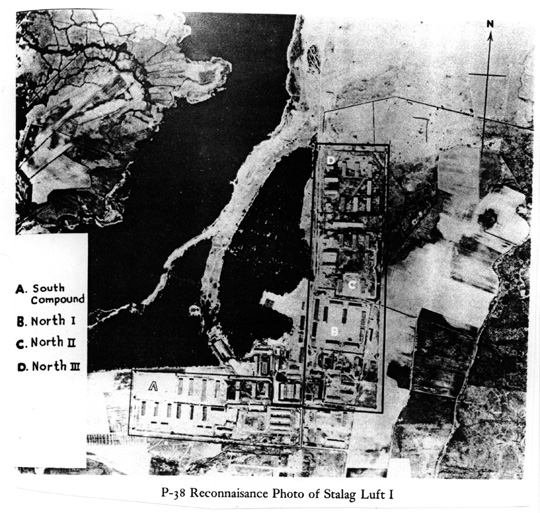|
Story of WW II Shoot Down and POW Experiences |
|||||
 |
 |
||||
|
Light at the End of the Tunnel The word was passed down to our boxcar that we would be marching into the new camp. They had just built this addition to the camp and we were designated to occupy the addition. We got our belongings which did not take but a few minutes. I tried to put on my shoes but my feet were too swollen and really hurt. I was weak from the bug eposide and the factor of malnutrition was taking its toll. The word came to fall out for the march except for those that felt they could not and I was still trying to put my shoes on. They were trying to find transportation for us but after waiting for some time it was suggested that if we wanted to try to walk we could take our time, so I forced my shoes on and we struggled off. With the help of one another we made the march of about three miles. I managed to walk to Stalag-Luft I, sick, sore and stinking and was assigned to North 1 Compound which only had three barracks. I found a corner in the barracks and established my claim. This compound had a mess hall where all rations were pooled and we had a staggered time to eat. The food was good and with some hot coffee or tea, we held on. There was a lot of room in our compound, so the option was mentioned in Southwest Compound, where Joe was housed and he took the gamble that he would have a chance to find me. So, on February 11, four days after our arrival, I heard someone call my name from the next room — Joe had found me. There was a good shower and we were allowed one shower a week. The water was turned on long enough to get wet and soap up, then the water was on again to rinse off. The American operator would leave it on extra long if the guard was not in or watching. Also, not too much was said if one fell in with another group for an extra shower. Joe and I cleaned up our clothing after living worse than animals. It took over two weeks before I could really walk. The room we were in was a large room and had two stoves for heating and cooking, if and when we had to. There were no beds or bunks and we all slept on the floor around the outside of the room which was on the south end of the building. It was not as cold here as at Stalag-Luft IV and we had more fuel for the stoves. Even though we slept on the floor it was not as cold. All we had was a bare room, no tables or bench, so we just used our bed area for everything. |
|||||
 |
|||||
|
The guard brought in a crew of Russian POWs who checked the building from the roof to underneath the barracks. While the Russians were under the building some floor boards moved up and they asked for items to trade. We received onions and potatoes and boards they had taken off with nails and all. Joe and I siezed on this opportunity to build a bunk in our corner with these boards. Two of the fellows in our barracks had illegal metal bars which we used as hammers to remove the nails, straighten them and to build a double bunk in our corner. We did not have many nails and no saw to cut the boards, so we had to break and use them the best we could. After a few hours of work the question came up, will it hold? First one of us got on it and moved around a bit and it held OK, so then we both got up on the top bunk with no problems of it falling down. We put our gear in the bunk and it sure was good to get off the floor. Even though sleeping or sitting on the bunk was the same as on the floor — just as hard — it was much easier and cleaner. Maybe the reason it held was that we had lost so much weight. I was at least one-half my normal weight. End of Chapter 9 |
|||||
|
Go to Cover — Introduction — Table of Contents Chapter — 1 — 2 — 3 — 4 — 5 — 6 — 7 — 8 — 9 — 10 — 11 — 12 — 13 Or Go To Home - Contact Us - Cold War Hist. - 91st SRS Hist. - Stardust 40 Mission Story |
|||||